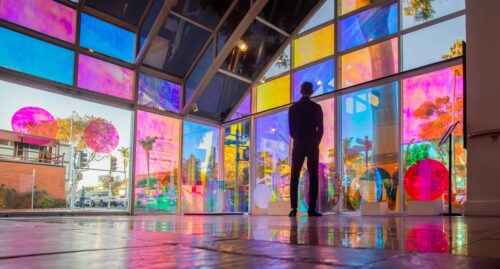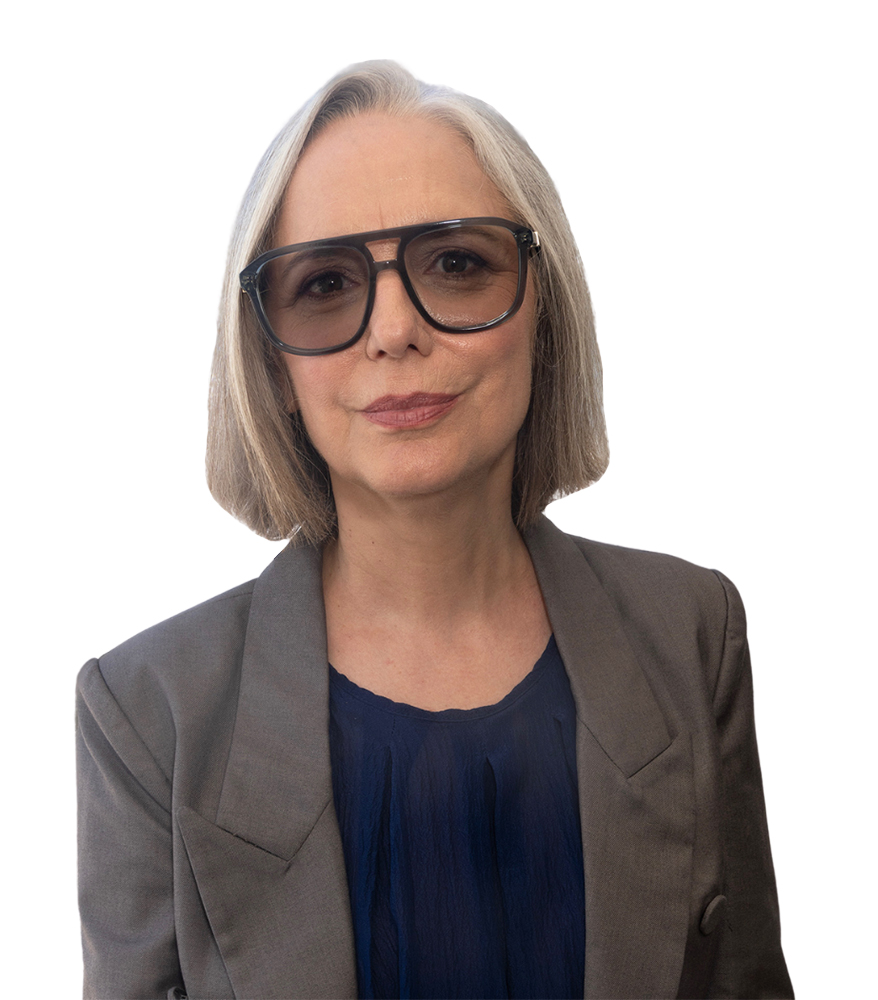5 Questions with Visionary Art Consultant Annie Wharton
Sep 1, 2025
Today we’re sitting down with Annie Wharton — a former exhibiting artist turned curator, before eventually launching her own gallery, then evolving into Annie Wharton Art Consulting in 2013. Phew! Based in Los Angeles, Annie has worked with everyone from first-time collectors to major developers, helping bring thoughtful, diverse art into both private and public spaces. With a deep love for emerging artists and nearly 4,000 studio visits under her belt, she’s got a unique pulse on the contemporary art world. Let’s dive into her journey, her projects, and her perspective on transitioning collections from the private to the public realm.
1AN: You’ve advised on everything from private acquisitions to large-scale public art projects. How do you tailor your approach depending on whether you’re working with an individual collector, a corporation, or a city agency?
Annie Wharton: Each project begins with a deep dive into the client’s goals: are we building upon an existing collection or creating something entirely new? What are the aesthetic, cultural, and financial priorities? What’s the timeline and context? Every client brings a unique set of constraints and ambitions, so my approach is always strategically tailored and creatively responsive.
For private collectors, the process tends to be more intimate and conversational. It’s about uncovering what resonates on a personal level and then shaping a collection that reflects their evolving interests, values, and worldview. These clients tend to be closely involved in artist selection, and I love facilitating that process where it becomes a collaborative and deeply creative exchange.
With corporate clients, I partner with architects, designers, and leadership teams to ensure the work reflects the company’s ethos and enhances the built environment. These projects require a special sensitivity to the client’s identity, spatial context, and stakeholder consensus.
Public art introduces an entirely different matrix of considerations: community engagement, site specificity, municipal review processes, fabrication logistics, and longer timelines. Across all sectors, my role is part curator, part strategist, and part translator, ensuring each decision is grounded in aesthetic intelligence and logistical precision.

1AN: I believe it! No doubt that public art projects, like the one at San Jose Airport or the Brooklyn school, involve a high degree of coordination and creativity. What’s the most rewarding and most challenging aspect of managing projects of this scale and visibility?
Annie Wharton: Public art is one of the most complex yet rewarding aspects of my practice. These projects invite artists to think on an architectural or infrastructural scale and ask them to consider how their work interacts with public space, civic identity, and community engagement, while at the same time meeting the technical and logistical demands of the built environment.

Projects often require multi-year timelines and the coordination of numerous stakeholders, including the organization’s staff, fabricators, artists, architects, and community members. It is important to protect the integrity of artist vision while navigating bureaucratic and logistical complexities with precision. It’s also vital to bring detailed knowledge of materials, fabrication techniques, permitting requirements, and stakeholder engagement strategies. All of these things are necessary to move public art projects from concept to completion and expand the artist’s oeuvre beyond any production limitations they may have within their studio.
The opportunity to create something that’s integrated into daily life is particularly fulfilling. Art that’s not sequestered within a white cube but is encountered unexpectedly, shaping how people move through and understand their environment. It democratizes access and sparks dialogue across audiences who may not otherwise engage with contemporary art. Seeing an artwork live in space, inspire curiosity, and become part of a city’s visual vocabulary is extraordinary.
1AN: Makes sense. And as for your private clients, I understand that many are not only acquiring for personal enjoyment but also thinking about long-term impact. How do you help collectors navigate the transition from acquiring for their homes to shaping a collection that could one day enter the public realm whether through loans, gifts, or legacy planning?
Years of close collaboration with artists and institutions have sharpened my instinct for identifying practices with lasting cultural and historical relevance beyond current market trends. That instinct is essential when advising clients who are shifting their focus from personal enjoyment to long-term legacy.
My work is always guided by a focus on quality of work and future relevance. Whether a client is just starting to collect or has an established collection of works, I help them clarify their curatorial objectives to find where narratives emerge and how those stories might evolve in dialogue with future audiences or institutions.
When that structure is in place, we can begin thinking strategically for the long term and most clients want to be very hands-on in shaping this trajectory. An art consultant can serve as both a strategic partner and cultural steward, helping to ensure that their investments appreciate materially and the collection evolves in meaningful ways. At its best, collecting can be a form of cultural authorship, a symphony composed of many parts.
1AN: Speaking of cultural authorship, how do you work with private collectors to support artists beyond purchasing work — for example, through private commissions or public projects?
Annie Wharton: Collectors who are interested in supporting artists beyond the acquisition of finished works also have an opportunity to participate in the creative process in an impactful way. This kind of engagement begins with conversations about intent. Sometimes it starts with a client who loves an artist’s work and wants them to create a site-specific installation for their new home or business. We ensure that those commissioning understand the artist’s conceptual framework, materials, and ambitions.
Once this foundation is established, a kind of reverse engineering is required to ensure a smooth development of the project’s scope and goals within the artwork site and available resources. This can look as simple as contracting an artist to create work in their style (I’d never ask an artist to alter their established visual or conceptual framework), but on a larger scale or to perfectly fit a specific space.
We also work with artists to create schemas for work and then bring in architects, fabricators, engineers, tile or stained-glass specialists, welders…whatever is needed to actualize the artists’ vision.
A thoughtfully executed commission or underwritten public art project allows commissioners to expand their comprehension of the creative process and assume the role of both custodian and peripheral participant in the way art is made, seen, and understood. This kind of patronage surpasses the transactional and moves toward a model of long-term investment in cultural production.

1AN: You’re currently leading projects across California, Florida, and New York. Are you seeing regional differences in what clients are looking for, either aesthetically or strategically, when it comes to building a contemporary art collection?
Annie Wharton: My work is anchored by a commitment to quality, integrity, and long-term vision. But yes, geography does help to shape how clients engage with contemporary art. Distinctions of place, market trends, and sometimes even climate can influence aesthetic preferences, the tempo of decision-making, or the philosophical framework clients bring to collecting.
That said, across California, Florida, and New York, the most consistent throughline is an appreciation for artwork that has conceptual rigor, emotional resonance, and the capacity to contribute meaningfully to broader cultural conversations. These are nuanced dialogues, often rooted in both historical awareness and forward-looking philanthropic goals.
My job is to interpret and navigate the multiplicity of differences in terrain. I try to introduce clients to artists whose practices can be universally appreciated.
Connect with Annie here.
Author

Annie Wharton
Annie Wharton loves to help emerging and established collectors find their ideal artworks. Based in Los Angeles, she is an art consultant, curator, and cultural strategist with a practice that encompasses contemporary art, public initiatives, and private and institutional acquisitions. As the founder of Annie Wharton Art Consulting, she leverages two decades of experience in placing artwork...
Recommended Videos
:sharpen(level=1):output(format=jpeg)/wp-content/uploads/2023/07/ASF23-promo-pics-3222.jpg)
Charlie Manzo, Alaina Simone, Muys Snijders, Kyle McGrath, Caren Petersen, Jason Rulnick, Elysian McNiff Koglmeier, Bianca Cutait, Linda Mariano, Jack Mur
:sharpen(level=1):output(format=png)/wp-content/uploads/2016/06/Steven-Schindler-1.png)
:sharpen(level=1):output(format=png)/wp-content/uploads/2016/06/Katherine-Wilson-Milne-1.png)
:sharpen(level=1):output(format=png)/wp-content/uploads/2016/10/Jacqueline-Towers-Perkins.png)
:sharpen(level=1):output(format=png)/wp-content/uploads/2018/10/Roxanne-Cohen.png)
:sharpen(level=1):output(format=png)/wp-content/uploads/2019/07/Alanna-Butera.png)
:sharpen(level=1):output(format=png)/wp-content/uploads/2016/01/Annelien-Bruins-1.png)
Steven R. Schindler, Katherine Wilson-Milne, Jacqueline Towers-Perkins, Roxanne Cohen, Alanna Butera, Annelien Bruins
:sharpen(level=1):output(format=png)/wp-content/uploads/2016/06/Steven-Schindler-1.png)
:sharpen(level=1):output(format=png)/wp-content/uploads/2016/06/Katherine-Wilson-Milne-1.png)
:sharpen(level=1):output(format=png)/wp-content/uploads/2016/10/Jacqueline-Towers-Perkins.png)
:sharpen(level=1):output(format=png)/wp-content/uploads/2016/01/Annelien-Bruins-1.png)
:sharpen(level=1):output(format=png)/wp-content/uploads/2018/05/Mary-Buschman-1.png)
:sharpen(level=1):output(format=jpeg)/wp-content/uploads/2015/12/Heidi-Lee-Komaromi1.jpg)
:sharpen(level=1):output(format=png)/wp-content/uploads/2017/04/Drew-Watson.png)
Steven R. Schindler, Katherine Wilson-Milne, Jacqueline Towers-Perkins, Annelien Bruins, Mary Buschman, Heidi Lee-Komaromi, Drew Watson

:sharpen(level=0):output(format=jpeg)/wp-content/uploads/2025/08/Annie-Wharton_Portrait-e1754357586179.jpg)
:sharpen(level=1):output(format=jpeg)/wp-content/uploads/2025/11/kian-lem-s_HqmrMsph8-unsplash-scaled-e1764007192632.jpg)
:sharpen(level=1):output(format=jpeg)/wp-content/uploads/2021/11/5-Things-You-Should-Do-When-Buying-Art.jpg)
:sharpen(level=1):output(format=webp)/wp-content/uploads/2025/11/sebastien-Laboureau-with-art-at-sagamore.jpg.webp)
:sharpen(level=1):output(format=jpeg)/wp-content/uploads/2025/11/Banner-Image.jpg)
:sharpen(level=1):output(format=jpeg)/wp-content/uploads/2025/11/Olga-de-Amaral.jpg)
:sharpen(level=1):output(format=jpeg)/wp-content/uploads/2025/11/F7642843-7A6C-4F72-964E-78BF1B6D4706_1_201_a-scaled.jpg)